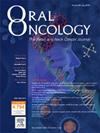Circulating tumor DNA in human papillomavirus-associated oropharyngeal cancer management: A systematic review
IF 4
2区 医学
Q1 DENTISTRY, ORAL SURGERY & MEDICINE
引用次数: 0
Abstract
Objective
Circulating tumor DNA (ctDNA) has emerged as a promising tool in the treatment of HPV-associated oropharyngeal squamous cell cancer (OPSCC). This systematic review sought to answer the question: what is the current role of ctDNA in the diagnosis, treatment, and surveillance of HPV-associated OPSCC?
Data sources
Medline (Ovid), Embase (Ovid), Scopus.
Review methods
Original articles studying the role of ctDNA in the diagnosis or surveillance of HPV-associated OPSCC were eligible for inclusion. Two authors independently reviewed studies for inclusion and abstracted data, including study design, characterization of liquid biopsy technology, and diagnostic outcomes.
Results
After a preliminary screening of 441 studies, 23 were selected for inclusion. Ten studies were conducted retrospectively, and 13 were conducted prospectively. In these studies, diagnostic testing included plasma-based droplet digital polymerase chain reaction (ddPCR, n = 13), quantitative PCR (qPCR, n = 4), digital PCR (dPCR, n = 3), next-generation sequencing (NGS) (n = 3), or a ctDNA detection kit (n = 1). Diagnostic outcomes were reported for pre-diagnosis (n = 1), pre-treatment (n = 17), during treatment (n = 6), and surveillance/recurrence (n = 11) timepoints. Test sensitivities ranged from 20.6 %–100 % pre-treatment and 72 %–100 % during surveillance, while test specificities ranged from 95 %–100 % pre-treatment and 87.2 %–100 % during surveillance.
Conclusion
The majority of studied ctDNA technologies allow for detection of HPV-associated OPSCC with high diagnostic accuracy. However, heterogeneity is introduced by test type and assay used. These findings highlight the utility, as well as limitations, of ctDNA in the diagnosis, treatment monitoring, and surveillance of HPV-associated OPSCC. Future studies and clinical consensus will need to address acceptable diagnostic accuracy thresholds for clinical use.
人乳头瘤病毒相关口咽癌管理中的循环肿瘤 DNA:系统综述
目的循环肿瘤DNA(ctDNA)已成为治疗HPV相关口咽鳞状细胞癌(OPSCC)的一种很有前景的工具。本系统综述旨在回答以下问题:ctDNA目前在HPV相关口咽鳞癌的诊断、治疗和监测中发挥着怎样的作用?综述方法研究ctDNA在HPV相关口咽鳞癌的诊断或监测中的作用的原创文章符合纳入条件。两位作者分别独立审查了纳入的研究并摘录了数据,包括研究设计、液体活检技术的特点以及诊断结果。其中 10 项研究为回顾性研究,13 项为前瞻性研究。在这些研究中,诊断测试包括基于血浆的液滴数字聚合酶链反应(ddPCR,n = 13)、定量 PCR(qPCR,n = 4)、数字 PCR(dPCR,n = 3)、新一代测序(NGS,n = 3)或 ctDNA 检测试剂盒(n = 1)。诊断结果报告的时间点包括诊断前(1 例)、治疗前(17 例)、治疗期间(6 例)和监测/复发(11 例)。检测灵敏度在治疗前为 20.6 %-100 %,监测期间为 72 %-100 %,检测特异性在治疗前为 95 %-100 %,监测期间为 87.2 %-100 %。然而,所使用的检测类型和检测方法也会产生异质性。这些发现凸显了ctDNA在诊断、治疗监测和监控HPV相关性OPSCC方面的实用性和局限性。未来的研究和临床共识将需要解决临床使用中可接受的诊断准确性阈值问题。
本文章由计算机程序翻译,如有差异,请以英文原文为准。
求助全文
约1分钟内获得全文
求助全文
来源期刊

Oral oncology
医学-牙科与口腔外科
CiteScore
8.70
自引率
10.40%
发文量
505
审稿时长
20 days
期刊介绍:
Oral Oncology is an international interdisciplinary journal which publishes high quality original research, clinical trials and review articles, editorials, and commentaries relating to the etiopathogenesis, epidemiology, prevention, clinical features, diagnosis, treatment and management of patients with neoplasms in the head and neck.
Oral Oncology is of interest to head and neck surgeons, radiation and medical oncologists, maxillo-facial surgeons, oto-rhino-laryngologists, plastic surgeons, pathologists, scientists, oral medical specialists, special care dentists, dental care professionals, general dental practitioners, public health physicians, palliative care physicians, nurses, radiologists, radiographers, dieticians, occupational therapists, speech and language therapists, nutritionists, clinical and health psychologists and counselors, professionals in end of life care, as well as others interested in these fields.
 求助内容:
求助内容: 应助结果提醒方式:
应助结果提醒方式:


